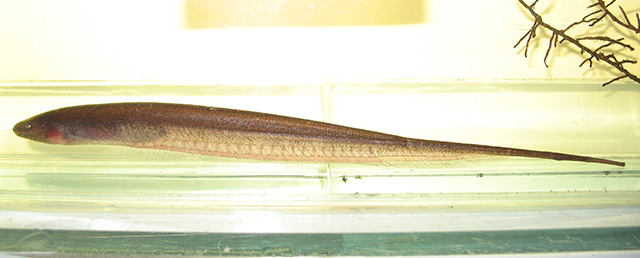| Hypopomidae (Bluntnose knifefishes) |
| 13.82 cm TL (male/unsexed) |
|
benthopelagic; freshwater; pH range: 3 - 4.5 |
| South America: Negro River basin in Brazil. |
|
Anal soft rays: 175-242. Procerusternarchus pixuna is distinguished from species of the genera Microsternarchus and Racenisia by the following characters: apomorphic presence of a deep, semi-transparent, large myogenic electric organ located along the body above the anal fin, between the ventral margin of the hypaxial muscle and dorsal margin of the anal fin muscle (pinnalis analis externalis) (vs. electric organ is not as deep and only semi-transparent at the end of the caudal); plesiomorphic condition of a fully-scaled body, with scalation on the dorsoanterior part of the body and along the middorsum, directly behind the extrascapular on the back of the head, on the nape (vs. scales absent from anterior upper to middle back); psiomorphic condition of 10 rows of embedded scales above the lateral line (vs. 3-4 in species of Microsternarchus and 4-5 in species of Racenisia); uniformly darker body; a dark line along the area above the lateral line (vs. back and top of the head also dark and a paler brownish ventral part of the body); and oblique band/blotches on the dorsal part of the body. Other characters useful to distinguish Procerusternarchus pixuna include: slightly projecting and elongated snout, 26.0-34.6% of head (H); head depth at occiput 49.7-68.9% of H; head length 1.2-14.5%; distance from eye to posterior naris, 3.9-10.9% of H; caudal filament length 19.1-27.5% of TL; caudal filament depth 1.1-1.9% of LEA; 175-242 anal-fin rays; 11-14 pectoral-fin rays; 13-15 pleural ribs, and 2-5 modified pleural ribs in the posteroventral wall of the abdominal cavity attached loosely and next to the first haemal spine;14-17 precaudal vertebrae; and 73-76 caudal vertebrae (Ref. 102656).
Description: caudal fin absent; urogenital papilla well developed in some individuals (Ref. 102656). |
| Inhabits black water streams along the middle and upper reaches of the Negro River Basin where it occurs in fast flowing waters, small falls and river margins with abundant submerged vegetation. During rainy season, has been collected in tangled roots of epiphytic plants that support a diverse fish assemblage. Feeds on insect larvae and parts (Ref. 102656). |
|
Least Concern (LC); Date assessed: 07 November 2018 Ref. (130435)
|
| harmless |
Source and more info: www.fishbase.org. For personal, classroom, and other internal use only. Not for publication.

